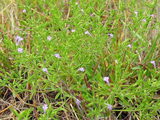Native Plants

Q. Who is Mr. Smarty Plants?
A: There are those who suspect Wildflower Center volunteers are the culpable and capable culprits. Yet, others think staff members play some, albeit small, role. You can torture us with your plant questions, but we will never reveal the Green Guru's secret identity.
Did you know you can access the Native Plant Information Network with your web-enabled smartphone?
Ask Mr. Smarty Plants is a free service provided by the staff and volunteers at the Lady Bird Johnson Wildflower Center.

rate this answer
Wednesday - February 19, 2014
From: Rosanky, TX
Region: Southwest
Topic: Erosion Control, Groundcovers, Grasses or Grass-like
Title: Native plants and grasses for river bank from Rosanky TX
Answered by: Barbara Medford
QUESTION:
Our property owners association would like to know what native plants/grasses to plant on the Blanco River bank in our river park to help prevent erosion. Some banks are steep and some areas are a gradual slope. Members want to know if it is preferable to leave downed trees and flood debris where they fall to prevent future erosion or if the better plan is to remove them and plant new trees and grasses. Our main goals are to protect our riverbank while also making sure property owners have access to enter the river and enjoy the water. Thank you for your help!ANSWER:
To answer your last question first, we would never recommend leaving debris, including fallen trees, on the ground. After all, you are in Bastrop County, and we understand we are already entering a period of Fire Danger warnings in Central Texas. Plus, it would be more difficult to plant and care for groundcovers with that debris present.
You mentioned steep banks but did not tell us about the sunlight available, so we are going to do a combination search on our Native Plant Database for groundcovers - some will be low and some will be high, so you will need to follow each plant link to our webpage on that plant, paying special attention to the growing conditions of each. We will check each to make sure it is native to your area before we add it to the list. Follow each plant link to our webpage on that plant, comparing water needs, size and growing conditions with what you are looking for.
First, some groundcovers that will do all right without too much sun - From a previous Mr. Smarty Plants answer for Austin:
Low groundcovers for part shade to shade in Central Texas:
Carex planostachys (Cedar sedge)
Low herbaceous blooming plants for part shade to shade in Central Texas.
Amblyolepis setigera (Huisache daisy)
Callirhoe involucrata (Winecup)
Calyptocarpus vialis (Straggler daisy)
Chamaecrista fasciculata (Partridge pea)
Dichondra argentea (Silver ponyfoot)
Glandularia bipinnatifida (Purple prairie verbena)
Hedeoma drummondii (Drummond's false pennyroyal)
Now, here are some taller grasses, for varying amounts of sun:
Andropogon gerardii (Big bluestem)
Aristida purpurea (Purple threeawn)
From the Image Gallery
More Groundcovers Questions
Ground cover for a slope in NY
April 04, 2010 - I live in New York State about 60 miles north of NYC. I have a very wide hill in the front of my house that I am just unable to keep up with. I can mow the bottom portion but using a weed trimmer fo...
view the full question and answer
Dense groundcover for full sun on the California coast.
November 08, 2011 - Can you recommend a very dense ground cover that serves as a lawn (in full sun on the coast, pref. drought resistant)?
Many thanks in advance.
view the full question and answer
Ground cover for Orange County, California
August 05, 2012 - What ground cover do you suggest for an Orange Co., CA, backyard with a steep slope in 3-4 hours of sun? Needs to grow fast to beat the weeds. Something pretty would be nice!
Thanks
view the full question and answer
Shade tolerant groundcover plants for Tarrant County, Texas
November 01, 2011 - I live in far NE Tarrant County (Ft Worth), TX and need a groundcover that can tolerate complete shade and poor, rocky, clay soil. I need mostly for erosion control, and needs to be relatively low
view the full question and answer
Ground cover for south-facing yard in Paris, TX
June 09, 2008 - We are moving to Paris, Tx. Our front yard faces south with 2 large sycamores shading it. Grass has a hard time growing here. I'd like to plant groundcover. Think it's sandy loam.
Do you have a...
view the full question and answer
| Support the Wildflower Center by Donating Online or Becoming a Member today. |

